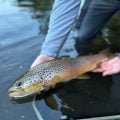How to Tie a Perdigon-Style Zebra Midge
Producer: Tim Flagler
“Really nothing new to see here, just taking a pretty standard Zebra Midge and tying it Perdigon style, so it’s heavy, small and sinks like a stone.
For a hook, I’m going to use a Lightning Strike JF2 jig hook in size 18. A 3/32” nickel colored slotted tungsten bead is a good match for the hook. Both the hook and the bead are quite small and handling them can be tricky. Getting hold of the hook with plunger-style hackle pliers really helps. Also, picking up the bead with your bodkin and getting it oriented, small hole up, between your fingertips, makes it much easier to thread on the hook. Sometimes you need to give the bead a little spin to get it around the bend. Once the bead’s in place, get the assembly firmly secured in the jaws of your tying vise. I have mine set up for rotary tying but it’s not essential. The slot on some beads like this one is asymmetrical. I prefer to put the longer slot on the underside of the hook shank with the shorter slot on top.
For thread, I’ve loaded a bobbin with a spool of black UTC 70 Denier. Get the thread started on the hook shank immediately behind the bead and take a few wraps rearward before snipping or breaking off the tag.
.015 lead-free wire is used to add weight and stabilize the bead. An 8” length is enough to make numerous flies. Place one end of the wire up into the slot of the bead and then secure it to the hook shank with a few turns of tying thread. This should anchor it enough so when you take wraps with it, it doesn’t just spin around the hook shank. After 4 or 5 turns, use your thumbnail to shear the excess wire off close. Take wraps of tying thread over top of and behind the wire, all the way back to the start of the hook bend.
In true Perdigon style, Coq de Leon fibers are used for the tail of the fly. After plucking a feather free from the skin, locate the nice, stiff, straight fibers and separate out 3 or 4. While keeping their tips aligned, strip them free from the stem and pass them to the fingertips of your right hand. Measure to form a tail a full hook in length and transfer that measurement rearward to the start of the bend. Use a pinch wrap to secure the fibers directly to the top of the hook shank and take wraps forward until you reach the wire. You can then snip the excess butt ends of the fibers off close.
Small-sized silver Ultra wire is used to rib the fly. Again, an 8” length will make numerous flies. Butt one end up against the wire weight and take thread wraps to secure it to the top of the hook shank and down the far side. You can then use your tying thread to cover up the wire wraps and create a tapered yet slim body on the fly. When you’re satisfied with the shape, get hold of the silver wire and take wraps or rotate your vise to rib and segment the fly. Four to five turns usually looks pretty good. Take wraps of tying thread to secure the wire right up against the back of the bead. Then brace the hook with the nozzle of your bobbin and helicopter to break the wire off close and clean. Do a 4 or 5 turn whip finish and snip or cut your tying thread free.
You could probably use the fly just like this but coating the body with your favorite UV cure resin will increase durability and streamline the fly so it sinks faster. After applying an ample drop of resin, I’ll use a cut-off little piece of feather, here wood duck, as a micro brush to push the resin evenly over the entire body and then use the UV torch to cure the resin. I do like to take it a step further and apply a thin coat of Hard as Nails over top of the UV cure. Blowing on it for a bit helps to set the polish enough so it won’t sag. I’ll then insert the hook point into the edge of a styrofoam coffee cup so it can be set aside to dry.
Again, nothing really new here, but a fantastic little fly none the less.”
How to Tie a Peg's Midge
How to Tie a Perfection Loop











